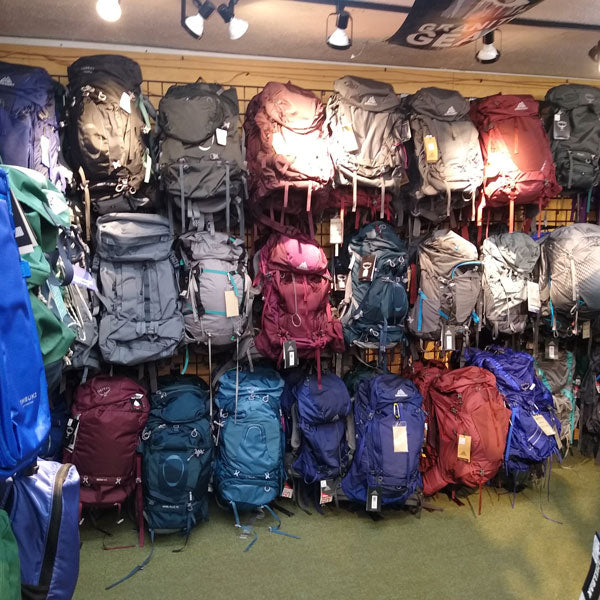
How to Buy a Backpack for Your Next Adventure!
Purchasing a backpack is often the best place to begin planning for a trip. While it is easy to get overwhelmed by gear decisions, a well-fitted backpack will keep you comfortable and help determine the sizes and types of other gear to pack. This post will help you sort out the differences between backpacks and let you know what to look for once you start shopping.
The most important thing about a backpack is its fit. Many backpacks come in small, medium, and large sizes, and packs aren’t just built for different uses, but also different body types. I’ll briefly talk about pack fitting later in this article, but there is no substitute for going into a store and being fit for a backpack by a professional.
The following are some important questions to ask yourself before shopping for a backpack:
• What is the intended use of your backpack?
• How long will your hiking trips be?
• How heavy is your hiking gear, and how much weight will you be carrying?
• How much use will you get out of this backpack?
In this article I’ll break down each of these questions further; we’ll discuss the types of backpacks, the importance of pack volume and suspension systems, and how pack fitting works and why it's important. At the end of the article, I’ll mention a couple of important accessories to consider, and provide examples of my favorite packs we carry at Next Adventure.
 What is the intended use of your backpack?
Types of backpacks
Walking into a retail store, you will notice that backpacks are displayed in different areas of the shop based on their intended use. The following are general categories of backpacks and some of their most common features:
Day Packs – Day packs are backpacks made for active day trips. They usually range in volume from 5 to 40 liters. Day packs are usually made from a technical nylon fabric designed to be lightweight and durable. Though they may have features such as water bladders or hip pockets, day packs are usually much simpler than backpacking bags. Day packs can be made with specific features for biking, skiing, running, or for any other type of outdoor activity.
Everyday Packs – Everyday packs (sometimes called lifestyle packs) are designed for commuting to the office, storage, shopping, etc. They are usually offered in the same size range as day packs, but will often be made from heavier, less technical canvas material with a different feature set. Common features include laptop sleeves and heavy-duty waterproofing. Shoulder slings and messenger bags fall into this category, as alternatives to 2-shoulder-strap backpacks.
Backpacking Packs – Backpacking packs range in volume from 35 to 90 liters, because they are designed to carry more gear for overnight use. They contain all sorts of features, zippers, and compartments designed for easy gear storage and multi-day use.
Travel Packs – Travel packs are designed to prioritize convenience of packing over comfort of wearing. Travel packs are a hybrid of a suitcase and a backpack. They aren’t designed to be worn long term, but are a convenient way to transport your luggage through the airport, between hostels, on short walks or hikes, etc. Travel packs have large space-efficient pockets, are sometimes designed to be the maximum airplane carry-on size, and will often include a detachable carry-on bag or day pack.
Miscellaneous pack types – There are a few other pack types to be aware of when shopping for a backpack. Lumbar Packs (also called fanny packs) are designed to buckle around your waist and take weight off the shoulders. These are good for running and short day hikes. Stowable packs are backpacks designed to stuff down into a tiny pocket or stuff sack; while they have no frame and can be uncomfortable to wear, they are great for travel or for carrying as a summit pack inside a larger overnight backpack. Kid carriers are backpacks designed to carry babies.
What is the intended use of your backpack?
Types of backpacks
Walking into a retail store, you will notice that backpacks are displayed in different areas of the shop based on their intended use. The following are general categories of backpacks and some of their most common features:
Day Packs – Day packs are backpacks made for active day trips. They usually range in volume from 5 to 40 liters. Day packs are usually made from a technical nylon fabric designed to be lightweight and durable. Though they may have features such as water bladders or hip pockets, day packs are usually much simpler than backpacking bags. Day packs can be made with specific features for biking, skiing, running, or for any other type of outdoor activity.
Everyday Packs – Everyday packs (sometimes called lifestyle packs) are designed for commuting to the office, storage, shopping, etc. They are usually offered in the same size range as day packs, but will often be made from heavier, less technical canvas material with a different feature set. Common features include laptop sleeves and heavy-duty waterproofing. Shoulder slings and messenger bags fall into this category, as alternatives to 2-shoulder-strap backpacks.
Backpacking Packs – Backpacking packs range in volume from 35 to 90 liters, because they are designed to carry more gear for overnight use. They contain all sorts of features, zippers, and compartments designed for easy gear storage and multi-day use.
Travel Packs – Travel packs are designed to prioritize convenience of packing over comfort of wearing. Travel packs are a hybrid of a suitcase and a backpack. They aren’t designed to be worn long term, but are a convenient way to transport your luggage through the airport, between hostels, on short walks or hikes, etc. Travel packs have large space-efficient pockets, are sometimes designed to be the maximum airplane carry-on size, and will often include a detachable carry-on bag or day pack.
Miscellaneous pack types – There are a few other pack types to be aware of when shopping for a backpack. Lumbar Packs (also called fanny packs) are designed to buckle around your waist and take weight off the shoulders. These are good for running and short day hikes. Stowable packs are backpacks designed to stuff down into a tiny pocket or stuff sack; while they have no frame and can be uncomfortable to wear, they are great for travel or for carrying as a summit pack inside a larger overnight backpack. Kid carriers are backpacks designed to carry babies.
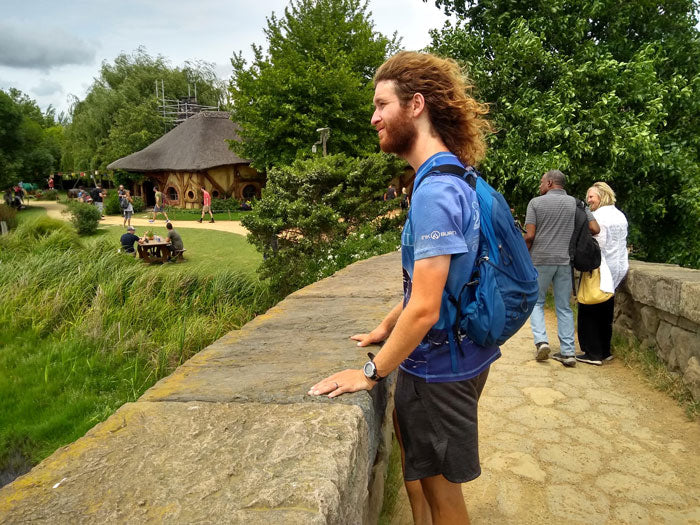 I often bring this stowable pack on longer backpacking and travel trips, for days when I don’t need to carry much gear
How long will your trip be?
Deciding on pack volume
It is important to distinguish between pack size and pack volume. Pack size refers to small, medium, and large (like clothes, backpack frames are designed to fit to a person’s body shape); pack volume refers to the carrying capacity of the backpack. In order to decide on a pack volume, you need to know how much gear you intend to carry. A general rule of thumb is that the longer the trip, the larger the backpack you might need. You might get away with a 5-liter day pack for a couple mile hike if you’re only carrying a water bottle and a granola bar; but for a longer hike where you’ll be carrying food, extra layers, first aid kit, water, etc., you'll need a much larger day pack. The same goes for a five-day backpacking trip versus a weekend one-nighter.
There are other factors to consider when selecting a pack volume. Winter hikes require more gear than summer hikes. When backpacking, some people also just prefer to carry more gear to make themselves comfortable in camp. If you carry a larger tent or camp furniture, or like to cook elaborate meals, consider a larger pack volume.
Ultralight packs are backpacks designed with minimal frames and fewer features, intended for people who like to travel fast and far. Ultralight packs don’t weigh much, but also can’t carry as much as traditional backpacking packs. These packs are popular for long-distance backpacking and thru-hiking.
I often bring this stowable pack on longer backpacking and travel trips, for days when I don’t need to carry much gear
How long will your trip be?
Deciding on pack volume
It is important to distinguish between pack size and pack volume. Pack size refers to small, medium, and large (like clothes, backpack frames are designed to fit to a person’s body shape); pack volume refers to the carrying capacity of the backpack. In order to decide on a pack volume, you need to know how much gear you intend to carry. A general rule of thumb is that the longer the trip, the larger the backpack you might need. You might get away with a 5-liter day pack for a couple mile hike if you’re only carrying a water bottle and a granola bar; but for a longer hike where you’ll be carrying food, extra layers, first aid kit, water, etc., you'll need a much larger day pack. The same goes for a five-day backpacking trip versus a weekend one-nighter.
There are other factors to consider when selecting a pack volume. Winter hikes require more gear than summer hikes. When backpacking, some people also just prefer to carry more gear to make themselves comfortable in camp. If you carry a larger tent or camp furniture, or like to cook elaborate meals, consider a larger pack volume.
Ultralight packs are backpacks designed with minimal frames and fewer features, intended for people who like to travel fast and far. Ultralight packs don’t weigh much, but also can’t carry as much as traditional backpacking packs. These packs are popular for long-distance backpacking and thru-hiking.
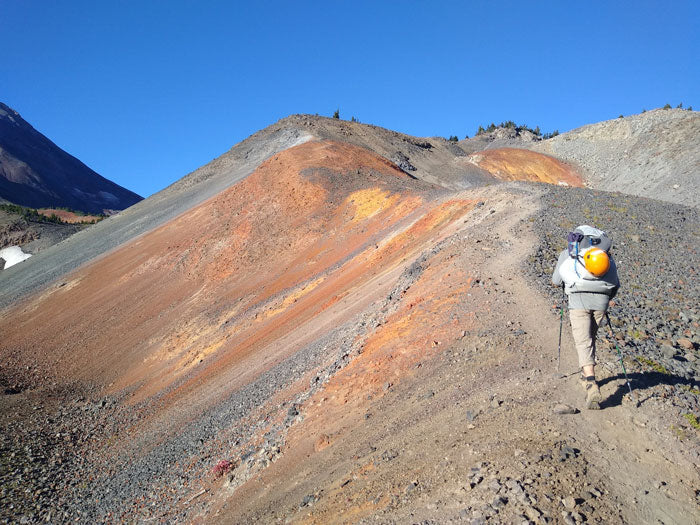 This ultralight pack is great for short, fast-paced backpacking trips
How much weight will you be carrying?
The importance of suspension systems
Suspension system refers to the assembly of straps and the back panel that hold the backpack on your back. Though all packs have a suspension system, the style of this system becomes especially important when looking at backpacking packs. There are two main categories of suspension system: Flat Back, and Mesh.
Flat Back systems are relatively simple- the part of the backpack that contacts your back is a relatively flat sheet of solid foam or fabric. Flat back systems are ideal for heavier loads; they fit more tightly against your body, can hold up to more stress, and their load is generally more stable. The downsides to this type of suspension system are that the pack is often less ventilated and hotter, and can feel heavier and chafe more than a lighter mesh suspension system.
This ultralight pack is great for short, fast-paced backpacking trips
How much weight will you be carrying?
The importance of suspension systems
Suspension system refers to the assembly of straps and the back panel that hold the backpack on your back. Though all packs have a suspension system, the style of this system becomes especially important when looking at backpacking packs. There are two main categories of suspension system: Flat Back, and Mesh.
Flat Back systems are relatively simple- the part of the backpack that contacts your back is a relatively flat sheet of solid foam or fabric. Flat back systems are ideal for heavier loads; they fit more tightly against your body, can hold up to more stress, and their load is generally more stable. The downsides to this type of suspension system are that the pack is often less ventilated and hotter, and can feel heavier and chafe more than a lighter mesh suspension system.
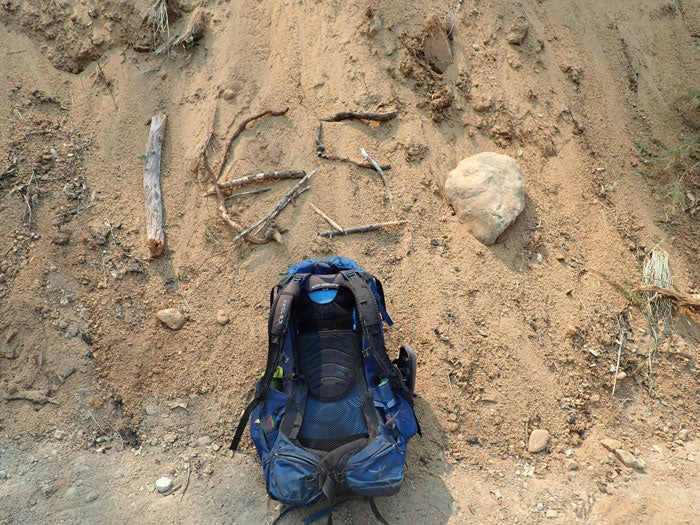 This flat-backed backpack is great for long trips and heavier loads
Mesh Back systems are more complicated: a tensioned sheet of mesh stretched across the back of the pack holds weight out and away from your body. Because they rely on tension and use less solid material, mesh backed packs are lighter, breathe easily, and can be very comfortable. However, mesh back systems don’t hold up well to heavier loads, which require a tighter fitting backpack; also, because mesh backed packs sit further from your body, they can feel less stable.
This flat-backed backpack is great for long trips and heavier loads
Mesh Back systems are more complicated: a tensioned sheet of mesh stretched across the back of the pack holds weight out and away from your body. Because they rely on tension and use less solid material, mesh backed packs are lighter, breathe easily, and can be very comfortable. However, mesh back systems don’t hold up well to heavier loads, which require a tighter fitting backpack; also, because mesh backed packs sit further from your body, they can feel less stable.
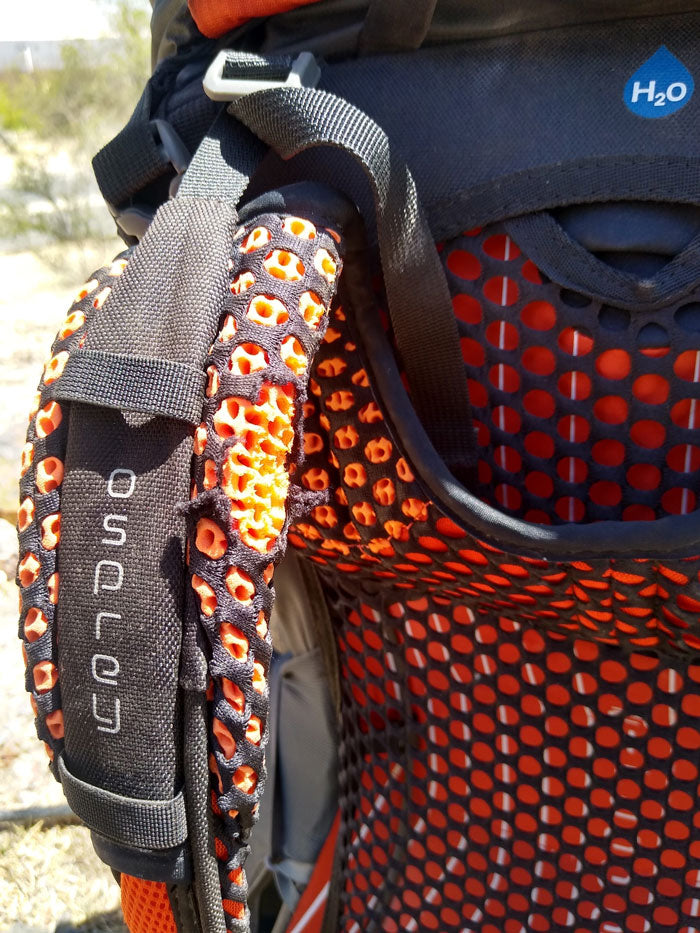 The mesh backing on this pack makes it feel light and airy... as long as you’re not carrying too much weight.
A general rule is that mesh backed packs are best for ultralight, minimal hiking trips, and flat backed packs are best for trips where you plan to carry a lot of luxuries or heavier gear.
How much use will you get out of this backpack?
Pack fitting and weighing your feature options
Backpacks come in a wide range of prices. Backpacking bags, for instance, range from $80 all the way to $700. What do you get for the extra money? Aside from the obvious—extra pockets, straps, features, etc. - more expensive packs will generally be more durable, and more customizable.
Think about how often you will use your new backpack. If you’re buying it to use once or twice on an already planned trip but don’t see yourself backpacking much in the future, a $100 backpack should do just fine. You won’t need too much durability over such a short time, and a little discomfort during a single trip is probably worth a couple hundred dollars in savings. These bargain backpacks come in a one-size-fits-all model which may or may not be adjustable. Keep in mind though, one-size-fits-all does not mean one size fits all well. More expensive backpacks will come in multiple sizes and different body shapes. With a proper pack fitting, these packs will always fit more comfortably than bargain packs.
The mesh backing on this pack makes it feel light and airy... as long as you’re not carrying too much weight.
A general rule is that mesh backed packs are best for ultralight, minimal hiking trips, and flat backed packs are best for trips where you plan to carry a lot of luxuries or heavier gear.
How much use will you get out of this backpack?
Pack fitting and weighing your feature options
Backpacks come in a wide range of prices. Backpacking bags, for instance, range from $80 all the way to $700. What do you get for the extra money? Aside from the obvious—extra pockets, straps, features, etc. - more expensive packs will generally be more durable, and more customizable.
Think about how often you will use your new backpack. If you’re buying it to use once or twice on an already planned trip but don’t see yourself backpacking much in the future, a $100 backpack should do just fine. You won’t need too much durability over such a short time, and a little discomfort during a single trip is probably worth a couple hundred dollars in savings. These bargain backpacks come in a one-size-fits-all model which may or may not be adjustable. Keep in mind though, one-size-fits-all does not mean one size fits all well. More expensive backpacks will come in multiple sizes and different body shapes. With a proper pack fitting, these packs will always fit more comfortably than bargain packs.
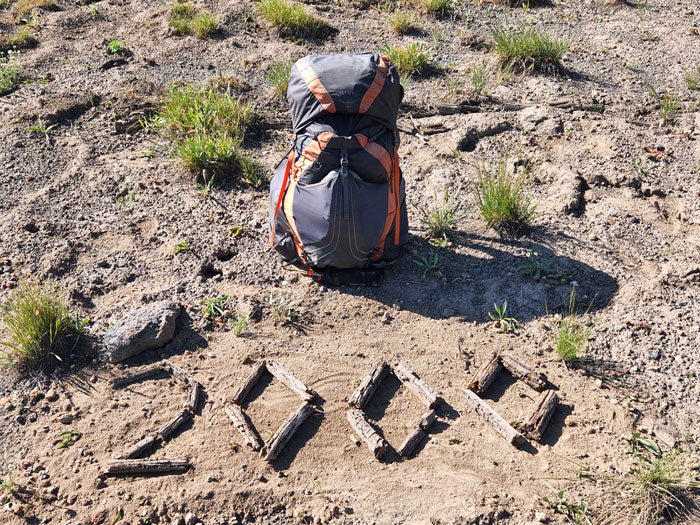 Though it’s a more expensive backpack, I’ve hiked thousands of miles with my well-fitted Osprey backpack
Why is pack fitting so important? In a nutshell: backpack straps need to fit properly around your shoulders and hips. Not only do the straps need to be the proper length, but the padding needs to fall in the proper place to prevent rubbing. During a pack fitting, a sales associate will measure your torso length and hip belt size. In many packs the pads can be shifted, the torso length adjusted, and the hip belt exchanged or resized. Many packs are offered in mens’ and womens’ models. Though the ideal pack won’t necessarily be determined by gender, the gender of the pack will determine the shape of the hip belt, shoulder, and chest straps. I can’t emphasize enough how important it is to go in for a pack fitting before purchasing a pack.
Pack accessories
There are a couple important accessories to consider purchasing with your new pack: a pack cover (or liner) and a water bladder.
Whether you are purchasing a day pack or a backpacking pack, pack covers are important for keeping the inside of your pack dry during rainstorms; they are an additional waterproof layer that stretches over the outside of the backpack. Pack covers come in a range of sizes, so make sure you get one that fits your backpack’s volume.
Though it’s a more expensive backpack, I’ve hiked thousands of miles with my well-fitted Osprey backpack
Why is pack fitting so important? In a nutshell: backpack straps need to fit properly around your shoulders and hips. Not only do the straps need to be the proper length, but the padding needs to fall in the proper place to prevent rubbing. During a pack fitting, a sales associate will measure your torso length and hip belt size. In many packs the pads can be shifted, the torso length adjusted, and the hip belt exchanged or resized. Many packs are offered in mens’ and womens’ models. Though the ideal pack won’t necessarily be determined by gender, the gender of the pack will determine the shape of the hip belt, shoulder, and chest straps. I can’t emphasize enough how important it is to go in for a pack fitting before purchasing a pack.
Pack accessories
There are a couple important accessories to consider purchasing with your new pack: a pack cover (or liner) and a water bladder.
Whether you are purchasing a day pack or a backpacking pack, pack covers are important for keeping the inside of your pack dry during rainstorms; they are an additional waterproof layer that stretches over the outside of the backpack. Pack covers come in a range of sizes, so make sure you get one that fits your backpack’s volume.
 Pack covers are important to have on wetter hiking trips
A water bladder (or hydration bladder) is a soft rubber bladder with a straw that fits inside the backpack and allows you to drink without stopping to pull out a water bottle. Many packs are designed with a water bladder pocket and hole to feed the hose through and out along a shoulder strap.
Pack covers are important to have on wetter hiking trips
A water bladder (or hydration bladder) is a soft rubber bladder with a straw that fits inside the backpack and allows you to drink without stopping to pull out a water bottle. Many packs are designed with a water bladder pocket and hole to feed the hose through and out along a shoulder strap.
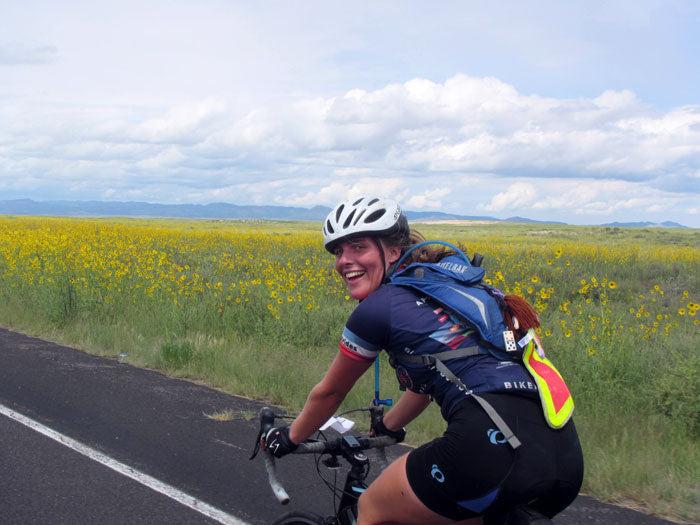 A hydration bladder allows you to drink water while on the go
Many packs come with pack covers, water bladders, or both, so check before purchasing either of these accessories.
Conclusion
Hopefully this guide has helped you decide what to look for when purchasing a backpack. Check out some of the links below to see examples of my favorite backpacks. Feel free to do your own research, but make sure you come into a retail store to be fitted for a pack! After choosing a backpack, it’s also a good idea to go home and fill it with weight or with your own gear and walk around your house or your neighborhood for a while. If the pack is uncomfortable, go back to the store to get it adjusted or exchanged before leaving on your next hike. Next Adventure, and most retail stores, will even offer fittings for packs you already own, so come into the shop before heading out on your next trip!
A hydration bladder allows you to drink water while on the go
Many packs come with pack covers, water bladders, or both, so check before purchasing either of these accessories.
Conclusion
Hopefully this guide has helped you decide what to look for when purchasing a backpack. Check out some of the links below to see examples of my favorite backpacks. Feel free to do your own research, but make sure you come into a retail store to be fitted for a pack! After choosing a backpack, it’s also a good idea to go home and fill it with weight or with your own gear and walk around your house or your neighborhood for a while. If the pack is uncomfortable, go back to the store to get it adjusted or exchanged before leaving on your next hike. Next Adventure, and most retail stores, will even offer fittings for packs you already own, so come into the shop before heading out on your next trip!
 A cat backpack
Staff Picks
A cat backpack
Staff Picks
 What is the intended use of your backpack?
Types of backpacks
Walking into a retail store, you will notice that backpacks are displayed in different areas of the shop based on their intended use. The following are general categories of backpacks and some of their most common features:
Day Packs – Day packs are backpacks made for active day trips. They usually range in volume from 5 to 40 liters. Day packs are usually made from a technical nylon fabric designed to be lightweight and durable. Though they may have features such as water bladders or hip pockets, day packs are usually much simpler than backpacking bags. Day packs can be made with specific features for biking, skiing, running, or for any other type of outdoor activity.
Everyday Packs – Everyday packs (sometimes called lifestyle packs) are designed for commuting to the office, storage, shopping, etc. They are usually offered in the same size range as day packs, but will often be made from heavier, less technical canvas material with a different feature set. Common features include laptop sleeves and heavy-duty waterproofing. Shoulder slings and messenger bags fall into this category, as alternatives to 2-shoulder-strap backpacks.
Backpacking Packs – Backpacking packs range in volume from 35 to 90 liters, because they are designed to carry more gear for overnight use. They contain all sorts of features, zippers, and compartments designed for easy gear storage and multi-day use.
Travel Packs – Travel packs are designed to prioritize convenience of packing over comfort of wearing. Travel packs are a hybrid of a suitcase and a backpack. They aren’t designed to be worn long term, but are a convenient way to transport your luggage through the airport, between hostels, on short walks or hikes, etc. Travel packs have large space-efficient pockets, are sometimes designed to be the maximum airplane carry-on size, and will often include a detachable carry-on bag or day pack.
Miscellaneous pack types – There are a few other pack types to be aware of when shopping for a backpack. Lumbar Packs (also called fanny packs) are designed to buckle around your waist and take weight off the shoulders. These are good for running and short day hikes. Stowable packs are backpacks designed to stuff down into a tiny pocket or stuff sack; while they have no frame and can be uncomfortable to wear, they are great for travel or for carrying as a summit pack inside a larger overnight backpack. Kid carriers are backpacks designed to carry babies.
What is the intended use of your backpack?
Types of backpacks
Walking into a retail store, you will notice that backpacks are displayed in different areas of the shop based on their intended use. The following are general categories of backpacks and some of their most common features:
Day Packs – Day packs are backpacks made for active day trips. They usually range in volume from 5 to 40 liters. Day packs are usually made from a technical nylon fabric designed to be lightweight and durable. Though they may have features such as water bladders or hip pockets, day packs are usually much simpler than backpacking bags. Day packs can be made with specific features for biking, skiing, running, or for any other type of outdoor activity.
Everyday Packs – Everyday packs (sometimes called lifestyle packs) are designed for commuting to the office, storage, shopping, etc. They are usually offered in the same size range as day packs, but will often be made from heavier, less technical canvas material with a different feature set. Common features include laptop sleeves and heavy-duty waterproofing. Shoulder slings and messenger bags fall into this category, as alternatives to 2-shoulder-strap backpacks.
Backpacking Packs – Backpacking packs range in volume from 35 to 90 liters, because they are designed to carry more gear for overnight use. They contain all sorts of features, zippers, and compartments designed for easy gear storage and multi-day use.
Travel Packs – Travel packs are designed to prioritize convenience of packing over comfort of wearing. Travel packs are a hybrid of a suitcase and a backpack. They aren’t designed to be worn long term, but are a convenient way to transport your luggage through the airport, between hostels, on short walks or hikes, etc. Travel packs have large space-efficient pockets, are sometimes designed to be the maximum airplane carry-on size, and will often include a detachable carry-on bag or day pack.
Miscellaneous pack types – There are a few other pack types to be aware of when shopping for a backpack. Lumbar Packs (also called fanny packs) are designed to buckle around your waist and take weight off the shoulders. These are good for running and short day hikes. Stowable packs are backpacks designed to stuff down into a tiny pocket or stuff sack; while they have no frame and can be uncomfortable to wear, they are great for travel or for carrying as a summit pack inside a larger overnight backpack. Kid carriers are backpacks designed to carry babies.
 I often bring this stowable pack on longer backpacking and travel trips, for days when I don’t need to carry much gear
I often bring this stowable pack on longer backpacking and travel trips, for days when I don’t need to carry much gear This ultralight pack is great for short, fast-paced backpacking trips
This ultralight pack is great for short, fast-paced backpacking trips This flat-backed backpack is great for long trips and heavier loads
This flat-backed backpack is great for long trips and heavier loads The mesh backing on this pack makes it feel light and airy... as long as you’re not carrying too much weight.
The mesh backing on this pack makes it feel light and airy... as long as you’re not carrying too much weight. Though it’s a more expensive backpack, I’ve hiked thousands of miles with my well-fitted Osprey backpack
Though it’s a more expensive backpack, I’ve hiked thousands of miles with my well-fitted Osprey backpack Pack covers are important to have on wetter hiking trips
Pack covers are important to have on wetter hiking trips A hydration bladder allows you to drink water while on the go
A hydration bladder allows you to drink water while on the go A cat backpack
A cat backpack
